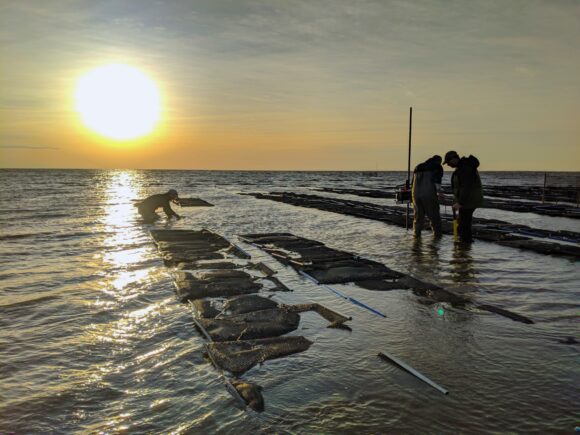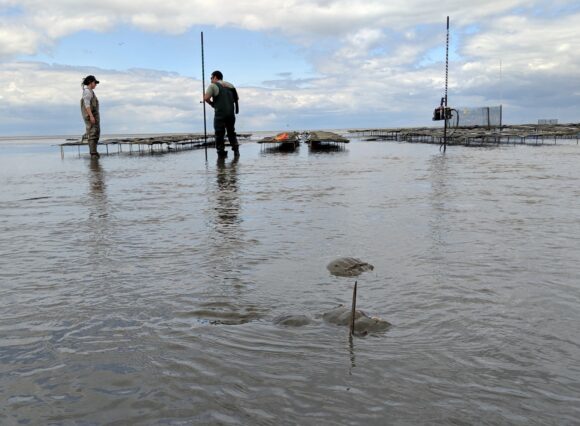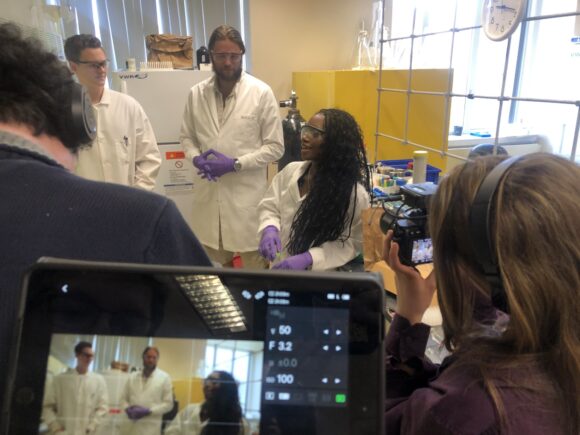
Science crew preparing for horseshoe crab behavior studies at sunset. In this photo, the people on the right are setting up a sonar that will operate during high tide (the water level will be at about their heads). The sonar will ‘watch’ the oyster racks that are around their feet and be used to count how many crabs walk through that farm to reach the upper beach slope which is towards the perspective of the camera.
Researchers at Rutgers School of Environmental and Biological Sciences (SEBS) have been exploring innovative ways to engage undergraduates in research and science learning. SEBS has undertaken a series of pilot projects that offer high school and undergraduate students ways to engage with STEM subjects in partnership with university scientists.
“As researchers and educators, we are interested in how students are motivated to create compelling environment stories for the public because of their sense of responsibility to the science and the featured scientists,” said Xenia Morin, associate teaching professor at SEBS and undergraduate program director of the Agriculture and Food Systems major.
Guided by science communication researcher Dena Seidel, undergraduates work in teams to develop science-in-action video stories about New Jersey marine ecosystems and plant-based crops and products developed to improve nutrition and public health.
“These students first establish trusting partnerships with researchers and then they document the scientific process over time. The students’ immersive learning includes the reiterative process of shaping many hours of science-in-action video data into story form that includes the scientists’ goals, research efforts and change over time,” said Seidel.

Horseshoe crab rest in a slough on the mudflats inshore of researchers who set up experiment monitoring equipment at low tide. In this picture you can see horseshoe crabs in a slough on the mudflats in the foreground, and researchers in the background setting up a sonar to monitor horseshoe crabs in the background. The sonar is being set up on the inshore edge of the oyster farm and during low tide, it will allow researchers to ‘watch’ horseshoe crabs as they move ashore to spawn.
The first completed science story, Life on the Edge: Exploring New Jersey’s Ocean Ecosystem, is a product of undergraduates Natalie Radu, a senior at Rutgers Business School, pursuing a SEBS minor in Plant Biology, Angie Catt, a SEBS sophomore majoring in Agriculture and Food Systems, and Micah Seidel, a SEBS sophomore majoring in Biological Sciences.
Their 15-minute video features a team of marine scientists, led by associate professor Daphne Munroe, studying the epic annual horseshoe migration that transforms New Jersey beaches.
“It is so important for students to have a chance to participate in research like this, that matters in the real world and contributes to sustainable solutions for coastal ecosystem,” said Munroe.
Every summer, New Jersey’s Delaware Bay hosts the world’s largest concentration of spawning horseshoe crabs that attracts magnificent migratory birds hungry for horseshoe crab eggs.
“Our story is about scientists, oyster farmers, and conservationists working together to preserve crucial New Jersey coastal ecosystems, while maintaining sustainable food production in the Delaware Bay. We learned so much environmental and food system science through this storytelling process,” said Catt.
Other student-led stories in development include Plants and Public Health, directed by Rutgers undergraduates Or Doni, a sophomore biological sciences major at the School of Arts and Sciences, and Emily Schneider, a junior at the School of Engineering, pursuing a minor in Agriculture and Food Systems.

Undergraduate students document the work of graduate student Kirsten Allen for “Plants and Public Health.”
“We began by reading the graduate students’ research papers so that we were fully prepared to interview them
These scientists have dedicated years of their lives to this project and so by creating this story, we are learning both about science and about the process of applying science in a way that truly benefits society,” said Doni.
Their project explores plant biologists who are developing a natural insect repellent from essential oils found in catnip that can be used in developing countries to protect against deadly diseases such as malaria, dengue and the Zika virus.
“We are science translators and this independent research project has taught us so much from the complexity of collaborative science to ways to effectively communicate this science to our peers,” said Schneider.
Rutgers offers a wide array of exciting opportunities for students to engage in science communication.

